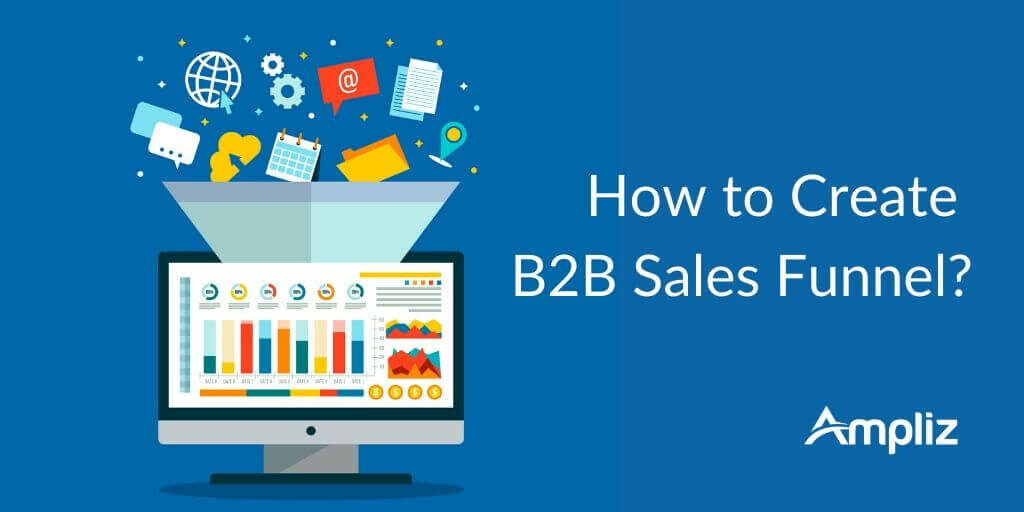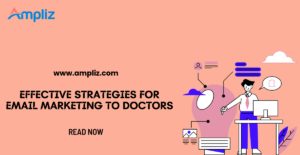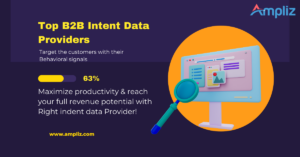Nothing can beat the happiness of seeing your imagination turning into reality, isn’t it!!. You are so proud and happy that finally you are done with the product development process. But the thought of finding and reaching out to the right customers makes you feel overwhelmed.
Finding the lead and converting it into a customer is an overwhelming process. B2B lead generation is a long process of generating leads, nurturing them, and finally converting them into high-paying long-term customers.
You can simplify this long and challenging process by making its blueprint. Before you start taking any action you must be clear with all the steps of the process. You must know how to start, what comes next, and so on.
This is when the sales funnel comes in. A sales funnel helps you understand customer behavior, improve sales strategy, and measure its effectiveness.
That’s why building a B2B sales funnel for your B2B business is so essential. Before we build your B2B sales funnel let’s understand what a sales funnel is.
The salesman should visualize his whole problem of developing the sales steps as the forcing by compression of a broad and general concept of facts through a funnel which produces the specific and favorable consideration of one fact. The process is continually from the general to the specific, and the visualizing of the funnel has helped many salesmen to lead a customer from Attention to Interest, and beyond (p. 109, Bond Salesman, William W. Townsend,1924) – Hathi Trust
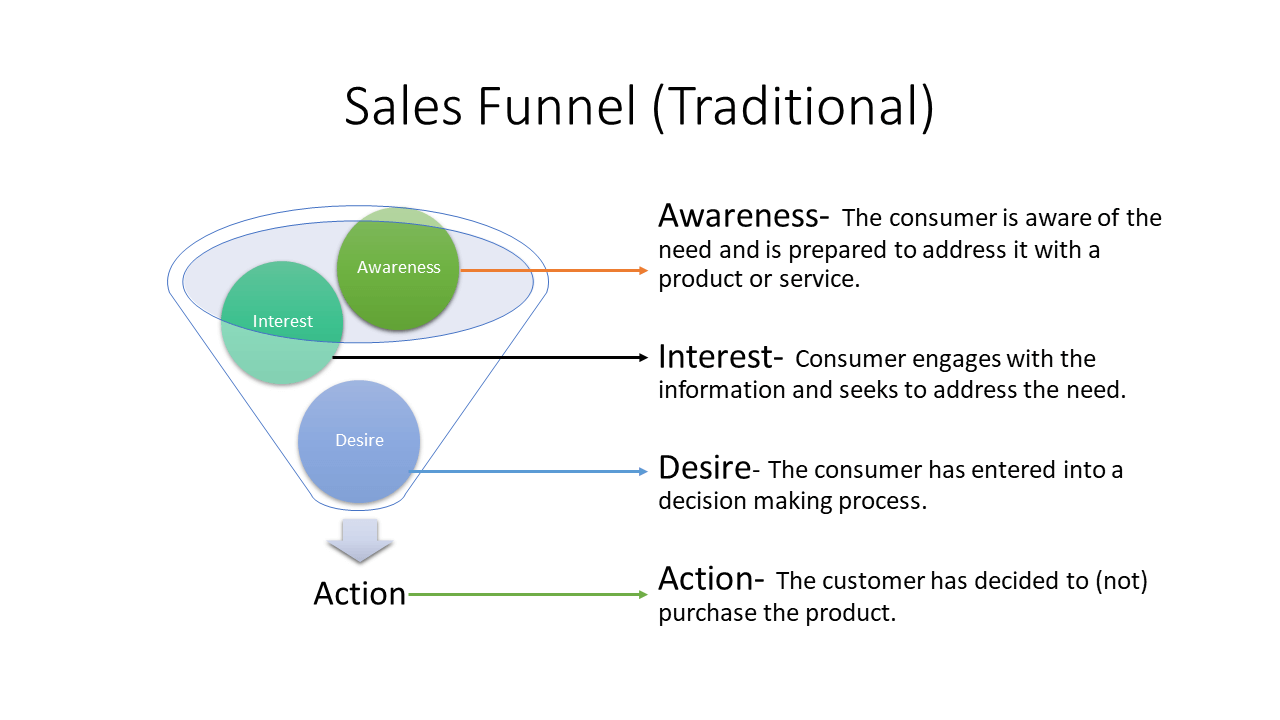
- Awareness– The consumer is aware of the need and is prepared to address it with a product or service.
- Interest– Consumer engages with the information and seeks to address the need.
- Desire– The consumer has entered into a decision making process.
- Action– The customer has decided to (not) purchase the product.
The McKinsey Quarterly, June 2009, Issue saw David Court and three co-authors introduce a more nuanced view of how consumers involve with brands: the “consumer decision journey” (CDJ).
They devised a model from the study of the purchase decisions of nearly 20,000 consumers across five industries and three continents. The evolved funnel also has four critical parts. They are:
- Consider – The consumer considers an initial set of brands based on brand perceptions and exposure to recent touch points. The journey initiates with the consumer’s top-of-mind consideration like a social media post, a blog post, a suggestion on a review site like G2 Crowd, Capterra, a cold mail, a referral mail, and various other avenues of information gathering. These entire act as stimuli to search about your brand, understand what you do, and consider your relevance to the customer.
- Evaluate – Consumers add or subtract brands as they evaluate what they want. They discuss with peers, read reviews, engage with collaterals on the website, and select (reject) few brands from the list. They deeply understand what they need. It continuously shifts there selection criteria and finally homing on the select few brands that more or less fit their purchase criteria.
- Buy – Ultimately, the consumer selects a brand at the moment of purchase. Here the customers explore and evaluate your product and service placement, product packaging, availability, pricing, and sales interactions. It is the most potent and delicate touchpoint.
- Enjoy, advocate, bond – The customer develops deeper relationships after using the product or service. They react negatively or positively based on the experience and spread the word also. When consumers are pleased with the purchase experience, they’ll advocate and become a brand evangelist for it by word of mouth. They create fodder for the evaluations of others and revitalizing and uplifting a brand’s potential. If disappointed by the brand, the customer is more likely to sever ties—or worse. But if the relationship becomes strong enough, they will enter an enjoy-advocate-buy loop that skips consider and evaluate stages in its entirety.
Customers today are more empowered and exposed to various mediums of information. They are more than just the numbers on the sales target board. The sales funnel B2B evolved into what it is today is due to two key reasons.
Firstly, the evolution of available information sources to the customers through which they can interact and influence each other buying decisions. Secondly, human relationships are dearer to companies today. A minor financial setback is recoverable over a period; however, it’s far more challenging to get rid of the tarnished brand image.
What is B2B sales funnel?
A sales funnel is a systematic process that businesses use to turn potential clients into paying customers. It is a structured journey that prospects go through, moving from initial awareness of a product or service to making a purchase decision.
When you build the sales funnel, converting leads into customers and increasing your ROI becomes easy.
But people often get confused between the sales funnel and sales pipeline. Let’s understand the basic difference between the two.
Difference between sales funnel and sales pipeline
The terms “sales funnel” and “sales pipeline” are often used interchangeably, but they refer to different aspects of the sales process.
Sales Funnel
A sales funnel is a visual representation of the customer journey from initial awareness to making a purchase. It typically includes stages like awareness, interest, consideration, intent, purchase, and retention. The focus is on the customer’s progression through these stages, and it helps businesses understand the conversion rates at each step.
In essence, a sales funnel is more customer-centric and describes the buyer’s journey from the top of the funnel (awareness) to the bottom (purchase).
Sales Pipeline
A sales pipeline, on the other hand, is a structured, systematic process that sales teams follow to move deals from initiation to closing. It’s a management tool that helps sales professionals track and manage individual opportunities or deals. The pipeline includes stages that align with the sales process, such as lead generation, qualification, proposal, negotiation, and closure.
The sales pipeline focuses on the actions taken by the sales team to move each potential deal through these stages. It’s a tool for sales management to monitor and optimize the overall sales process, ensuring that opportunities are progressing smoothly.
In summary, the sales funnel is more customer-focused and represents the buyer’s journey, while the sales pipeline is a tool for sales management to track and manage the various deals in progress. Both concepts are interconnected and crucial for a comprehensive understanding and effective execution of the sales process.
To make an effective sales funnel you must know what are the different stages involved in it. Let’s see which are these stages.
Different B2B Sales Funnel Stages
The sales funnel consists of several stages that represent the customer’s journey from initial awareness to making a purchase. While the number of B2B sales funnel stages can vary, a typical B2B sales funnel includes the following:
Awareness
This is the stage where potential customers become aware of your product or service. It often involves marketing efforts to attract attention, such as content marketing, advertising, or social media engagement.
You can do content marketing through blog posts, social media engagement, online advertising, and participating in industry events. For instance, a software company might create informative blog posts about industry challenges to attract attention.
Interest
In this stage, potential customers show interest in your offering. They might explore your website, download resources, or sign up for newsletters. Content like webinars, case studies, or whitepapers can be effective at this point.
You can elevate their interest by providing valuable resources like webinars, whitepapers, or ebooks. Continuing with the software company example, they might offer a free webinar on addressing common industry problems to engage prospects more deeply.
Consideration
Prospects actively consider your product or service. They evaluate features, and benefits, and compare it with your competitors. You must provide detailed content, product demonstrations, and testimonials during this stage.
By sharing in-depth content, case studies, and comparison guides you can increase your chances of being considered. The software company could provide detailed case studies showcasing successful implementations of their software.
Intent
At the intent stage, prospects express a clear interest in moving forward. This could involve requesting a quote, proposal, or demonstration. The focus is on understanding their specific needs and aligning your solution with those needs.
At this stage they request a demo, ask for a personalized quote, or engage in one-on-one consultations. In our software example, potential clients might request a personalized demo to understand how the software fits their specific requirements.
Purchase
This is the stage where the actual sale happens. Contracts may be signed, and payment transactions take place. At this stage, you should emphasize making the buying process as smooth as possible.
You must actively include contract signings, payment transactions, and delivery of the product or service. For the software company, this stage involves finalizing the licensing agreement and providing access to the software.
Retention
Post-purchase, the goal is to retain the customer. Retaining customers is equally important as attracting new ones. Customers retain and choose you over your competitors when they are satisfied with your product or service and post-purchase. Closing a deal doesn’t mean your job is done, rather it begins. Customers may face various challenges with your product that you have to overcome so that they leverage all the functions of your product effectively.
By providing excellent customer support, ensuring satisfaction, and possibly offering additional products or services you can contribute to customer loyalty and long-term relationships.
By providing ongoing customer support, regular communication, and offering updates or additional services you retain yours. The software company would provide continuous support, and updates, and perhaps introduce new features to maintain a positive relationship with the customer.
Understanding these stages helps you tailor your marketing and sales efforts to guide potential customers through the funnel efficiently, ultimately leading to successful conversions and customer retention.
Creating an effective B2B customer acquisition funnel involves several strategic steps to guide potential clients through the buying process. Here’s a step-by-step B2B sales funnel strategy
B2C vs B2B Sales Funnel
The B2B marketing sales funnel is a crucial aspect of any business, but it can look quite different depending on whether you are selling to consumers (B2C) or other businesses (B2B).
While the overall goal of both types of funnels is to convert leads into customers, there are some key differences in how they operate.
In a B2C marketing sales funnel, the focus tends to be on creating an emotional connection with the customer. This might involve using social media and influencer marketing to build brand awareness and generate interest.
The emphasis is on making the customer feel good about their purchase and building loyalty over time.
On the other hand, B2B sales funnels typically require more targeted outreach and a longer lead time. Companies may need to identify decision-makers within an organization and persuade them through case studies or demos that their product or service will meet specific business needs.
Trust-building is also essential as companies want assurance that they’re investing in something reliable.
Both types of sales funnels have unique challenges, but by understanding these differences, businesses can tailor their approach accordingly for maximum success.
how to create a b2b sales funnel?
Define Your Target Audience
Identifying and understanding your ideal B2B customers is the very first step in building a target audience. You must focus on the audience who must have a similar buying history or search history as your product. You must target the audience whose problems and pain can be solved by your product, and whose goals and needs can be fulfilled. You must target those people who have a budget to buy your product and have the power to make buying decisions.
Create Awareness
Once you define your target audience, then comes the implementation of targeted marketing strategies to create awareness. You can do this through content marketing, social media campaigns, and participation in relevant industry events.
To engage your readers with your content you must create relatable and engaging content. This is possible when you know your audience well in terms of their needs, goals, and pain points.
Generate Interest
Once you create awareness of your brand among your audience, next comes generating interest. And this can be done by developing engaging content such as webinars, whitepapers, and case studies to capture the interest of your audience. You should tailor content to address common pain points or challenges your target customers face.
Provide Educational Content for Consideration
Offer in-depth content that educates potential clients about your product or service. This could include product demonstrations, detailed guides, and comparison materials to aid in the decision-making process.
Facilitate Intent
Make it easy for prospects to express their intent to move forward. Provide clear calls-to-action for requesting demos, and quotes, or engaging in personalized consultations.
Streamline the Purchase Process
Simplify the buying process by providing transparent pricing, easy contract negotiations, and efficient onboarding. Address any concerns or objections promptly.
Implement Post-Purchase Strategies for Retention
Develop a robust post-purchase strategy to retain customers. This could involve ongoing customer support, regular communication, and opportunities for upselling or cross-selling additional products or services.
Utilize Technology and Tools
Implement customer relationship management (CRM) tools to track leads, automate certain processes, and gain insights into customer interactions. Analyze data to optimize your sales funnel continually.
Monitor and Analyze Metrics
Regularly monitor key performance indicators (KPIs) at each stage of the sales funnel. Metrics like conversion rates, lead generation effectiveness, and customer acquisition costs can provide valuable insights for refinement.
Iterate and Improve
Continuously evaluate the performance of your B2B sales funnel and be open to making adjustments based on data and feedback. This iterative approach ensures your sales funnel remains effective and adaptive to changing market dynamics.
How to calculate sales conversion rate
To calculate the sales conversion rate, you can use the following formula:
Conversion Rate=(Number of ConversionsNumber of Visitors)×100%Conversion Rate=(Number of VisitorsNumber of Conversions)×100%
Simply divide the number of conversions (successful sales) by the total number of visitors to your website or store, and then multiply by 100 to express the result as a percentage.
Conclusion
Thus, building a sales funnel will help you to move from one step to the next in the client acquisition process smoothly. This also helps clear communication between the marketing team and sales team which in-turn increases conversion rate.
How does a B2B sales funnel work?
The sales funnel for B2B works based on the prospects’ engagement with the brand. Candidates progress down the B2B sales funnel as they become aware of your products or services through interactions with marketing and sales collaterals on the website, sales representatives, and their interest grows till they finally convert and become customers.
Based on the model you choose apart from the models aforementioned. The numbers of steps vary from 3 to 7 levels. Apart from having different nomenclature, the B2B sales funnels have a singular task, i.e., transform an unaware lead to a paying customer.
The funnel can be into four necessary parts, or we can call it a 4 part customer journey cycle.
1. The first part consumer considers an initial set of brands based on their perception of exposure to various customer touchpoints, e.g., cold emails, ads, social media posts, events, and other digital/non-digital collaterals. It is the awareness stage.
2. Consumer evaluates and removes brands based on their requirements.
3. The consumer selects a brand and purchases at the moment of sale.
4. The purchase of a product or the service becomes an experience, and it builds expectations. The customer comes to buy again and creates more experiences and resets expectations to a new high or low.
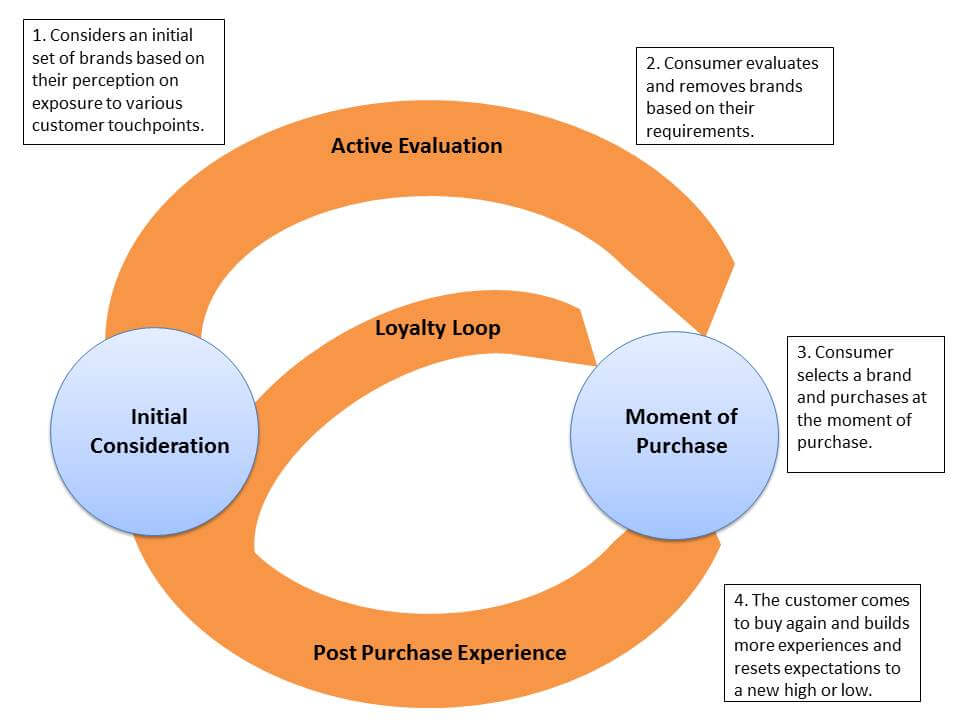
Read Also: B2B Sales Funnel Stages
Customer Journey Action Plan
Launch a pilot project similar to your original product and research your customers’ journey. Talk to your customers directly and understand all the touchpoints that your customers crossed to arrive at choosing you.
Find out everything possible about our customers: what they see, what they do, and what they say.
Find out what channels they use to research on products, how engaged or mindful in those channels, and what they like to share in those channels. Make minimal assumptions about your customers. Lesser the premises better the understanding.
Find out what products from individual brands would they choose to buy without giving a second thought to it and why. Try to know what is the most hated or liked the advertisement they last saw. Ask them why they liked or disliked it.
With social media monitoring tools find out what people say about your customers. Which is the most relevant keyword for you? Find out what excites them about your customer and one thing they dislike about your competitors.
Find out which channels are available to you for interaction with the customers. Is it the review websites (G2 Crowd, Capterra, Bobsguide, and others), social media (LinkedIn, Twitter, Facebook, VK, and others), specific product review blogs (Gartner Blog) and various other places where they come in contact with the brand directly or indirectly?
Find out of these touchpoints which influence their purchase decision the most and why.
Develop plans for community and social-based initiatives to encourage traffic inflow and build credibility. Aggressively distribute positive third-party reviews across traditional as well as social media to build ongoing post-purchase relationships and encourage brand advocacy for you.
Create an action plan for the customer experience that aligns with the customer journey plan, which will extend the brand boundaries. The details of a customer experience plan vary according to the products, target segments, campaign strategy, and media mix. It makes the movement of the customer between different layers of funnel fluid.
Why Are B2B Sales Funnels Important?
A sales funnel B2B, in simpler terms, is a mapping of the customer decision journey that aligns with your business goals. The worst that can happen to any B2B company is remain ignorant of the current customer journey and blaming low sales and poor results on a slow market or its sales force.
In the beginning, the losses are slower; however, as competitors adapt and get in front of the pecking order, the late or non-adopters will start losing fast till they’re completely obliterated of the market if they continue to be clueless.
Read Also: B2B Sales Funnel Template


